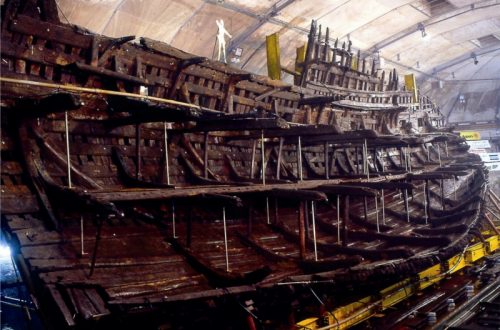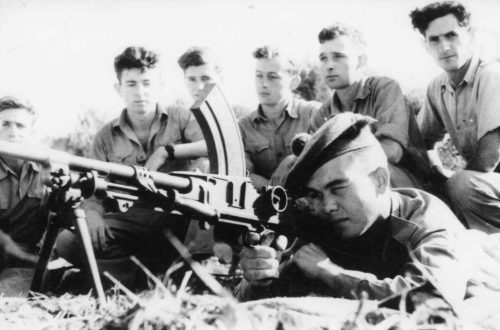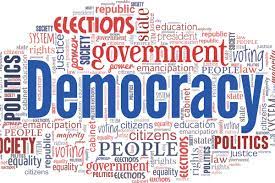Guest post by Michael Ezra
Few events in the history of the United States have been more controversial than President Harry S. Truman’s decisions in 1945 to use the atomic bomb against Japan. On August 6 of that year an atomic bomb was dropped on Hiroshima. Three days later another bomb fell on Nagasaki. These cities were chosen for their military significance. As Henry Stimson, the U.S. Secretary of War, who recommended the bombing, put it:
Hiroshima was the headquarters of the Japanese Army defending southern Japan and was a major military storage and assembly point. Nagasaki was a major seaport and it contained several large industrial plants of great wartime importance. [1]
While estimates of the number of casualties vary, the US Strategic Bombing Survey put the mid- estimate for Hiroshima at 75,000 dead, and for Nagasaki at 35,000 dead. These figures include the fallout from radiation. There is no doubt that most of the dead were innocent civilians. [2]
That some regard this decision as a war crime is understandable. It is also a simplistic view that ignores the horrors of the alternatives.
Germany unconditionally surrendered to the Allied forces on May 8, 1945. Japan did not. On July 26, 1945 the leaders of the United States, Great Britain and Nationalist China issued the Potsdam Declaration. This declaration called on Japan “to proclaim now the unconditional surrender of all the Japanese armed forces… The alternative for Japan is prompt and utter destruction.” [3] Japanese Prime Minister Suzuki Kantaro announced the following the day that their government would “ignore” the Potsdam Declaration. The word he actually used was “Mokusatsu.” This word, as Sadao Asada comments, “has been variously translated as ‘withhold comments,’ ‘treat with silent contempt,’ ‘ignore with contempt,’ ‘unworthy of public notice,’ and even ‘reject.'”[4]
On December 7, 1941, Japan had attacked the US naval base at Pearl Harbor killing over 2,000 Americans and wounding many more. The Japanese later shelled an oil storage field near Santa Barbara and bombed Oregon. Moreover, nearly one thousand Japanese balloon bombs reached the United States and many more reached Canada.[5]
This was not the first Japanese aggression.
In 1931, Japan had ruthlessly taken control of Manchuria and by 1937, Japan had invaded the rest of China. One particularly horrific Japanese atrocity was the Rape of Nanking. Estimates of those massacred range from 45,000 to 350,000.[6] “By the beginning of 1945,” notes David Gordon, “the Japanese occupied more Chinese territory than at any time since 1937.”[7]
On the day of the Pearl Harbor attack, the Japanese had invaded Thailand.[8] The Japanese also attacked Malaya and the Philippines. Before the end of 1941 the Japanese had invaded Burma and Hong Kong. In 1942, Singapore fell and Japan attacked Australia.[9] Excluding American casualties, over 17 million deaths are attributable to the Japanese Empire between 1931 and 1945.[10]
By April 1945, the Japanese were anticipating an American invasion. Their strategy was to inflict as much damage as possible on American troops. In addition to ground troops, they had a kamikaze air strength totaling over 4,800.[11] The assault, known as OLYMPIC, was being planned for the southern Japanese island of Kyushu and was due to commence on November 1, 1945. As the military historian Edward Drea notes, US intelligence had decrypted countless messages from Japanese high command that “underlined Japanese determination to fight to the death.”[12] General MacArthur predicted 105,500 casualties in the first ninety days and a further 12,600 non-battle losses.[13] The Japanese army was estimated to be 5 million in size [14] and reinforcements were flooding into Kyushu, with an estimated 560,000 troops there by the beginning of August. There were also 773 kamikaze planes in Kyushu; naval authorities thought that these alone could sink 30-40 percent of the incoming convoy. The intelligence was clear.[15]
The potential loss of life was horrific. As Truman subsequently wrote to a correspondent, the use of the atomic bomb was “a means to end the war and save 250,000 men from being killed on our side, and that many on the Japanese side, plus twice that many being injured for life.” [16] Truman’s figures, frequently criticised as excessive, may have been underestimates. Former President Herbert Hoover had compiled a report predicting that the invasion would cost 500,000-1,000,000 lives.[17] A study by the Nobel laureate William Shockley had concluded:
the Japanese dead and ineffectives at the time of the defeat will exceed the corresponding number for the Germans. In other words, we shall probably have to kill at least 5 to 10 million Japanese. This might cost us between 1.7 and 4 million casualties including between 400,000 and 800,000 killed.[18]
In his definitive recent study, Richard Frank estimates the number of Japanese civilian and military deaths from a land invasion on Kyushu alone at between “580,000 and 630,000 at the very low end.”[19] The use of the atomic bomb averted this scenario. Moreover, as D. M. Giangreco and Kathryn Moore have pointed out, production of Purple Hearts for injured soldiers dramatically increased as the invasion approached. The end of the war meant that these were not required. The US ended the war with “The most wonderful of all its surplus: 495,000 unused Purple Hearts.”[20]
I agree with the words of Henry Stimson from 1947:
The decision to use the atomic bomb was a decision that brought death to over a hundred thousand Japanese. No explanation can change that fact and I do not wish to gloss over it. But this deliberate, premeditated destruction was our least abhorrent choice. The destruction of Hiroshima and Nagasaki put an end to the Japanese war.[21]
To those who argue that the use of the atomic bomb on Hiroshima and Nagasaki was a crime, I reply: it would have been a greater crime not to use it.
End Notes
[1] Henry L. Stimson, “The Decision to Use the Atomic Bomb,” Harper’s Magazine, 194, February 1947 pp. 97-107. Available on line
[2] “United States Strategic Bombing Survey: The Effects of the Atomic Bombs on Hiroshima and Nagasaki,” June 30, 1946. (Confidential File, Truman Papers, Harry S. Truman Library, Independence, Missouri) p. 15. Available on line (N.B. Large file)
Barton Bernstein gives the range of deaths from the two bombs from 100,000 which he considers too low to 340,000 which he views as way too high. Barton J Bernstein, “Truman and the A-Bomb: Targeting Noncombatants, Using the Bomb, and His Defending the ‘Decision'”, The Journal of Military History, Vol. 62, No. 3. (Jul., 1998), pp. 547-570. Richard Frank, gives a range of 100,000-200,000 dead in both cities. Richard B. Frank, Downfall: The End of the Imperial Japanese Empire, (London: Penguin Books, 2001) p. 287
[3] Winston S. Churchill, The Second World War, Volume 6: Triumph and Tragedy, (London: Penguin Books, 2005) pp. 556-557
[4] Sadao Asada, “The Shock of the Atomic Bomb and Japan’s Decision to Surrender: A Reconsideration,” Pacific Historical Review Vol. 67, No. 4, (November 1998) pp. 477-512
[5] Clark G. Reynolds, “Submarine Attacks on the Pacific Coast, 1942,” The Pacific Historical Review, Vol. 33, No. 2. (May, 1964), pp. 183-193, John. E. Pike, Bruce G. Blair and Stephen I. Schwartz, “Defending Against the Bomb,” in Stephen I. Schwartz ed., Atomic Audit: The Costs and Consequences of U.S. Nuclear Weapons Since 1940. (Washington D.C., Brookings Institution Press, 1998) pp. 269-326
[6] David M. Gordon, “The China-Japan War, 1931-1945,” The Journal of Military History Vol. 70 (January 2006) pp. 137-182.
[7] Ibid.
[8]Kenneth P. Landon, “Thai Non-Resistance: A Footnote to History,” Far Eastern Survey, Vol. 13, No. 23. (Nov. 15, 1944), pp. 220-222.
[9]Daniel Marston ed. The Pacific War Companion: From Pearl Harbor to Hiroshima, (Oxford: Osprey Publishing, 2007) pp. 12-15
[10] Robert P. Newman, Truman and the Hiroshima Cult, (East Lansing: Michigan State University Press, 1995) p. 138
[11]Robert A. Pape, “Why Japan Surrendered,” International Security, Vol. 18, No. 2. (Autumn, 1993), pp. 154-201
[12] Edward J. Drea, “Previews of Hell: Intelligence, the Bomb, and the Invasion of Japan,” MHQ: The Quarterly Journal of Military History Vol. 7 No. 3 (Spring 1995) pp. 74-81.
[13] Ibid.
[14] Henry L. Stimson, “The Decision to Use the Atomic Bomb,” op. cit.
[15] Edward J. Drea, “Previews of Hell: Intelligence, the Bomb, and the Invasion of Japan,” op. cit.
[16] Harry S. Truman to Mrs. Haydon Klein, Jr., August 4, 1964. (Post- Presidential File, Truman Papers, Harry S. Truman Library, Independence, Missouri.) Available on line
[17] D.M. Giangreco, “‘A Score of Bloody Okinawas and Iwo Jimas’: President Truman and Casualty Estimates for the Invasion of Japan,” Pacific Historical Review, Vol. 72. No. 1 pp. 93-132
[18] D. M. Giangreco, “Casualty Projections For the U.S. Invasions Of Japan, 1945-1946: Planning and Policy Implications,” Journal of Military History, Vol. 61, No. 3, (July 1997), pp. 521-581. Available on line
[19] Richard B. Frank, Downfall: The End of the Imperial Japanese Empire, op. cit., p. 194
[20]D. M. Giangreco and Kathryn Moore, “Half a Million Purple Hearts,” in Robert James Maddox ed., Hiroshima in History: The Myths of Revisionism, (Columbia, Missouri: University of Missouri Press, 2007) pp. 116-119
[21] Henry L. Stimson, “The Decision to Use the Atomic Bomb,” op. cit.


